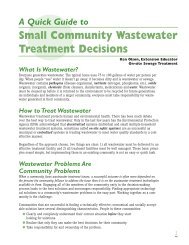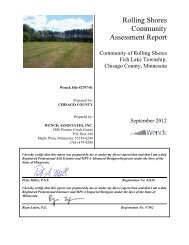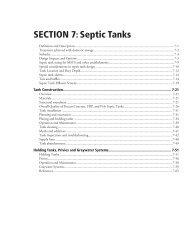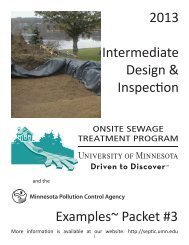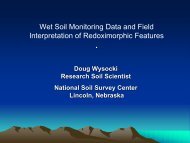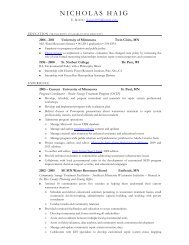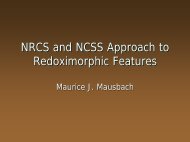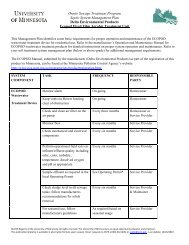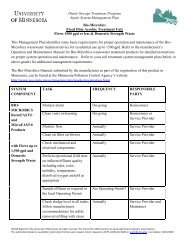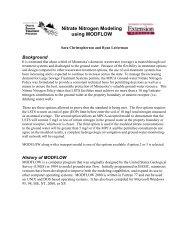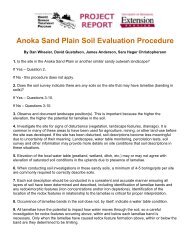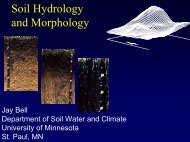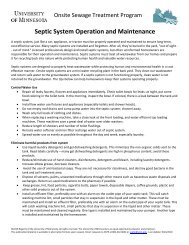MPCA Design Guidance for Large Subsurface Wastewater ...
MPCA Design Guidance for Large Subsurface Wastewater ...
MPCA Design Guidance for Large Subsurface Wastewater ...
Create successful ePaper yourself
Turn your PDF publications into a flip-book with our unique Google optimized e-Paper software.
These guidelines are the recommended procedures <strong>for</strong> estimating the design flow and pollutant-loading<br />
conditions and are considered to be the minimum values necessary to assure adequate treatment facility<br />
capacity. It is expected that sound engineering judgment will be used to determine the appropriate<br />
design conditions <strong>for</strong> each treatment facility and that consideration will be given to impacts of decisions<br />
on upstream and downstream unit processes.<br />
See the <strong>MPCA</strong> <strong>Design</strong> Flow and Loading Determination Guidelines <strong>for</strong> <strong>Wastewater</strong> Treatment Plants<br />
fact sheet at www.pca.state.mn.us/publications/wq-wwtp5-20.doc <strong>for</strong> additional discussion regarding<br />
design flow determination.<br />
The flow conditions that are critical to the design and operation of an LSTS include both the average<br />
flow and the peak flow.<br />
The average flow used <strong>for</strong> LSTS is the average daily flow <strong>for</strong> the wettest seven-consecutive-day period.<br />
This includes an amount <strong>for</strong> infiltration and inflow and is defined as the average wet weather (AWW)<br />
design flow <strong>for</strong> an LSTS. The AWW flow is the flow used to determine whether a permit is required<br />
and <strong>for</strong> the sizing treatment units and drainfield disposal areas.<br />
The peak flows used <strong>for</strong> LSTSs are called the peak hourly wet weather (PHWW) flow and the peak<br />
instantaneous wet weather (PIWW) flow. The PHWW flow is the peak flow during the peak hour of<br />
the day at a time when the ground water is high and the number of connections to the LSTS is at full<br />
occupancy, and a five-year one-hour storm event is occurring. The five-year one-hour storm event <strong>for</strong><br />
the specific project area may be determined from the map attachment in the <strong>MPCA</strong> <strong>Design</strong> Flow<br />
Determination Guidelines documents at www.pca.state.mn.us/publications/wq-wwtp5-20.doc.<br />
The PIWW flow is the peak instantaneous flow during the day at a time when the ground water is high<br />
and the number of connections to the LSTS is at full occupancy and a 25-year one-hour storm event is<br />
occurring. To determine the appropriate 25-year, one-hour storm event, refer to Map No. 2 at<br />
www.pca.state.mn.us/publications/wq-wwtp5-20.doc.<br />
The PHWW and PIWW flows are critical in the design of septic tanks, sewer systems, pumping<br />
facilities, and other components. Peak flows are important <strong>for</strong> septic tank capacity to ensure that solids<br />
are retained. Other treatment units also consider peak flow values to be certain that the units can accept<br />
the peak flow rate without backing up or overflowing.<br />
A. Flow determination <strong>for</strong> existing dwellings<br />
The AWW flow determination <strong>for</strong> systems serving existing dwellings where the bedroom numbers<br />
are known shall consist of the sum of the AWW flows <strong>for</strong> each individual dwelling unit as<br />
determined in either (1) or (2) below. It is recommended that flows be determined by both methods<br />
and the largest value used <strong>for</strong> design of the disposal system. When determining AWW flow with<br />
these methods, the change in dwelling usage and the potential <strong>for</strong> changes in the number of<br />
bedrooms shall be considered.<br />
1) Measured flow. The flow monitoring period <strong>for</strong> any particular project must record flow data<br />
during critical wet weather flow events at peak occupancy which have occurred during a<br />
sustained wet weather flow period. For existing dwellings that have daily flow measurements<br />
over a peak water use period, the design AWW flow can be determined by averaging the<br />
highest consecutive seven-day measured values. Note: This procedure cannot be used to<br />
determine if a permit is needed, but it could be used <strong>for</strong> design purposes.<br />
2) Estimated flow. For existing dwellings with the number of bedrooms <strong>for</strong> each dwelling known,<br />
the design AWW flow can be estimated from applying the following equation to Table 1:<br />
Permit Flow = the total flow from the ten highest flow dwellings + (total flow from the<br />
remaining dwellings * 0.45) + I/I (see Attachment 2 Step 6). Note: This procedure is used to<br />
determine if a permit is needed and can also be used <strong>for</strong> design purposes.<br />
<strong>Design</strong> <strong>Guidance</strong> <strong>for</strong> <strong>Large</strong> <strong>Subsurface</strong><br />
Minnesota Pollution Control Agency<br />
<strong>Wastewater</strong> Treatment Systems April 2010<br />
5



